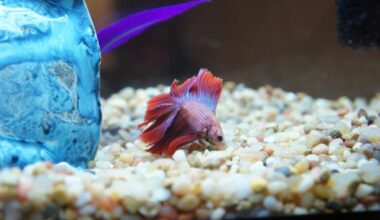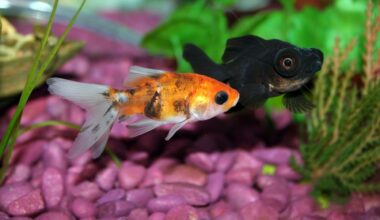Biopellets have been used in the aquarium scene for a few years, and some owners swear by them.
But overall there are a lot of new or prospective tank owners who don’t know much about them. The issue is a lot of the information about biopellets is scattered throughout various forums, and there isn’t a clear resource that covers everything you need to know.
That’s where we come in.
Table of Contents
What Are Biopellets?
Biopellets are little biodegradable pellets that contain bacteria to help your tank thrive.
You need a solid amount of good bacteria in your tank in order to facilitate a healthy ecosystem and keep nitrate levels in check. A tank with too many nitrates can become a victim of significant algae growth, or the loss of aquatic life.
No one wants that, so some tank owners use biopellets as a way to make sure their tank continues to thrive.
It’s a rather simple process, you use a biopellet reactor to pass water through your biopellets. This introduces that healthy bacteria into your water so they can keep nitrates and toxins at bay.
If you’re using a protein skimmer there are benefits to introducing biopellets into your aquarium as well. The combination of biopellets and a protein skimmer typically leads to improved skimming performance, which is great for your water.
Are They Right For You?
This is where you’ll quickly start to get diverging opinions depending on who you talk to.
Some aquarists still use biopellets in their tanks and swear by them. Others think it’s unecessary and prefer alternative options.
The Skimmer Combo
If you’re someone who is using a protein skimmer (and you probably should be), biopellets are definitely worth considering. The increased skimmer performance you get when using biopellets is just one of the benefits.
The other advantage to this combination is that you can get away with phasing out GFO from your tank treatment. Biopellets are easier to manage and will save you a lot of time in the long run.
Bioload Plays A Part Too
If you have a heavy bioload in your tank then you’re much more likely to see significant results by using biopellets. This is because there’s more waste, nitrates, and algae to worry about.
However, if you’re someone who has a very light bioload it’s probably not worth exploring biopellets.
Some Good Biopellet Options (Based On Our Reviews)
If you’re thinking about giving biopellets a try we have a couple of reviews and recommendations for you.
1. Two Little Fishies ATLNPX0 Npx Bioplastics Polymer
These biopellets have been around for a while and are extremely well-liked in the aquarium community. Chances are if you ask a few experienced tank owner about what kind of biopellets they use, this product will come up more than once.
These are made from biodegradable polymers that efficiently deliver bacteria into the water. They are made for use in fluidized reactors so that’s something to be aware of depending on your setup.
It might take a few weeks for you to notice nitrate reduction, but that’s normal. This sort of thing can take a little time since you’re trying to facilitate new growth in your tank.
If our biopellet review could only contain one product, this would probably be it. We highly recommend it.
2. Kolar Labs Metabolix Biopellets
The Kolar Labs biopellet line is another great choice for people looking for a high-quality product. These can be used in freshwater and saltwater, and are safe for all kind of fish.
Kolar Labs swears by their strict quality standards when it comes to their products, and their biopellets are no different. They’ve amassed a wave of strong feedback over the years, and show no sign of a drop off in quality.
If you have an algae problem these biopellets are a great choice. There are a number of users who have seen significant algae reductions after introducing these into their tank setup.
The Two Most Common Mistakes When Using Biopellets
Over the last few years since biopellets started to get serious use in the aquarium community, there have been two common mistakes that happen over and over. These still happen so regularly that we thought it was important to point them out before moving on.
Running Without A Skimmer
Like we mentioned earlier, it’s a great investment to have one of the best protein skimmers running in your tank. Not only will it drastically improve your water quality, it goes great with biopellets.
This one-two punch will allow you to see major changes in the level of nitrates and waste in your tank. It’s highly recommended that you use the two together.
Overloading Your Tank
It’s very common to hear horror stories about aquarium owners who pick up biopellets and put the pedal to the metal. They don’t ramp up the amount over time and this overloads the tank.
As a result, the full system can fail due to a sharp decrease in levels. If you want to avoid this, follow the instructions and increase the amount slowly.
Some Biopellet Alternatives
Before we sign off, you don’t have to use biopellets to remove toxins from your tank. In fact, recently there has been a trend among aquarists to seek out some of these alternatives instead of biopellets.
You can use things like vodka or vinegar to achieve a similar effect on your tank. The advantages of this are that you can control the dose a bit better which can prevent you from making any mistakes and going too far.
If you choose to go this route you’ll be manually adding these to your tank and will be more involved when it comes to measuring and tweaking dose levels.
We’re not saying one is better than the other, they just have different advantages. Personally, we feel that if you take the time to dial in the proper delivery of your biopellets, it’s a bit easier to manage in the long term (once you get it up and running).
But ultimately it’s up to you!

